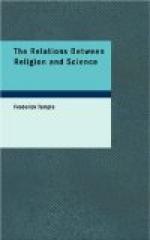In the first place, the unity of plan which can be found pervading any great class of animals or plants seems to point to unity of ancestry. Why, for instance, should the vertebrate animals be formed on a common plan, the parts of the framework being varied from species to species, but the framework as a whole always exhibiting the same fundamental type? If they all descended from a common ancestor, and the variations were introduced in the course of that descent, this remarkable fact is at once accounted for. But, in the second place, observation shows that slight variations ARE perpetually being introduced with every successive generation, and many of these variations are transmitted to the generations that follow. In the course of time, therefore, from any one parent stock would descend a very large variety of kinds. But if, in the third place, it be asked why this variety does not range by imperceptible degrees from extreme forms in one direction to extreme forms in the other, the answer is to be found in the enormous prodigality and the equally enormous waste of life and living creatures. Plants and animals produce far more descendants than ever come even to such maturity as to reproduce their kind. And this is particularly the case with the lower forms of life. Eggs and seeds and germs are destroyed by millions, and so in a less but still enormous proportion are the young that come from those that have not been destroyed. There is no waste like the waste of life that is to be seen in nature. Living creatures are destroyed by lack of fit nourishment, by lack of means of reproduction, by accidents, by enemies. The inevitable operation of this waste, as Darwin’s investigation showed, has been to destroy all those varieties which were not well fitted to their surroundings, and to keep those that were. One species of animal has been preserved by length of neck, which enabled it to reach high-growing fruits and leaves; another by a thicker skin, which made it difficult for enemies to devour; another by a colour which made it easier to hide. One plant has been preserved by a bright flower which attracted insects to carry its pollen to other flowers of its kind; another by a sweet fruit which attracted birds to scatter its seed. Meanwhile other animals and plants that had not these advantages perished for the lack of them. The result would be to maintain, and perpetually, though with exceeding slowness, more and more to adapt to the conditions of their life, those species whose peculiarities gave them some advantage in the great struggle for existence.
Here again we have the working of known laws of life, capable of accounting for what we see. And the high probability cannot be denied that by evolution of this kind the present races of living creatures have been formed. And to these arguments the strongest corroboration is given by the frequent occurrence, both in plants and animals, of useless parts which still remain as indications of organs that once were




